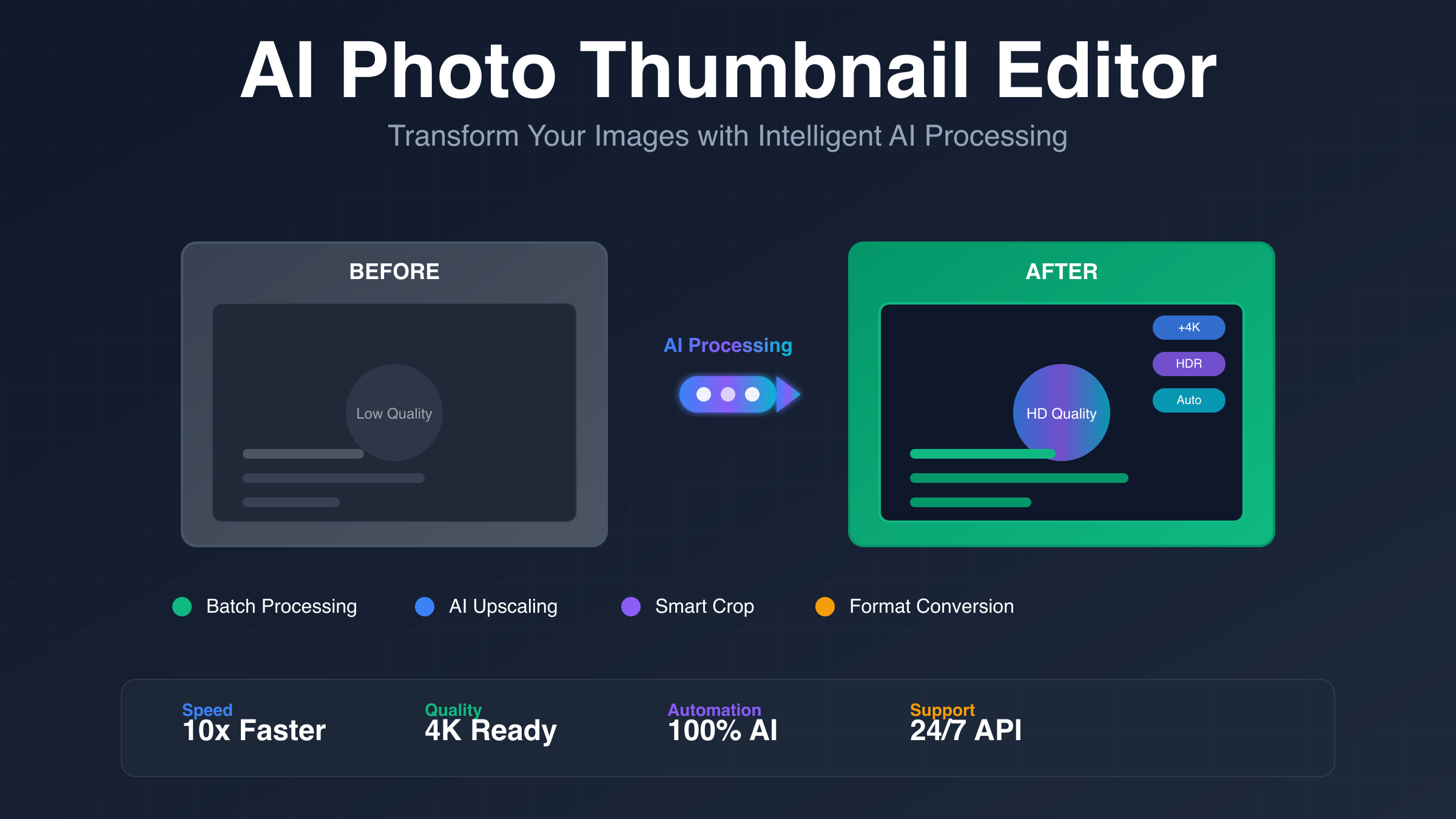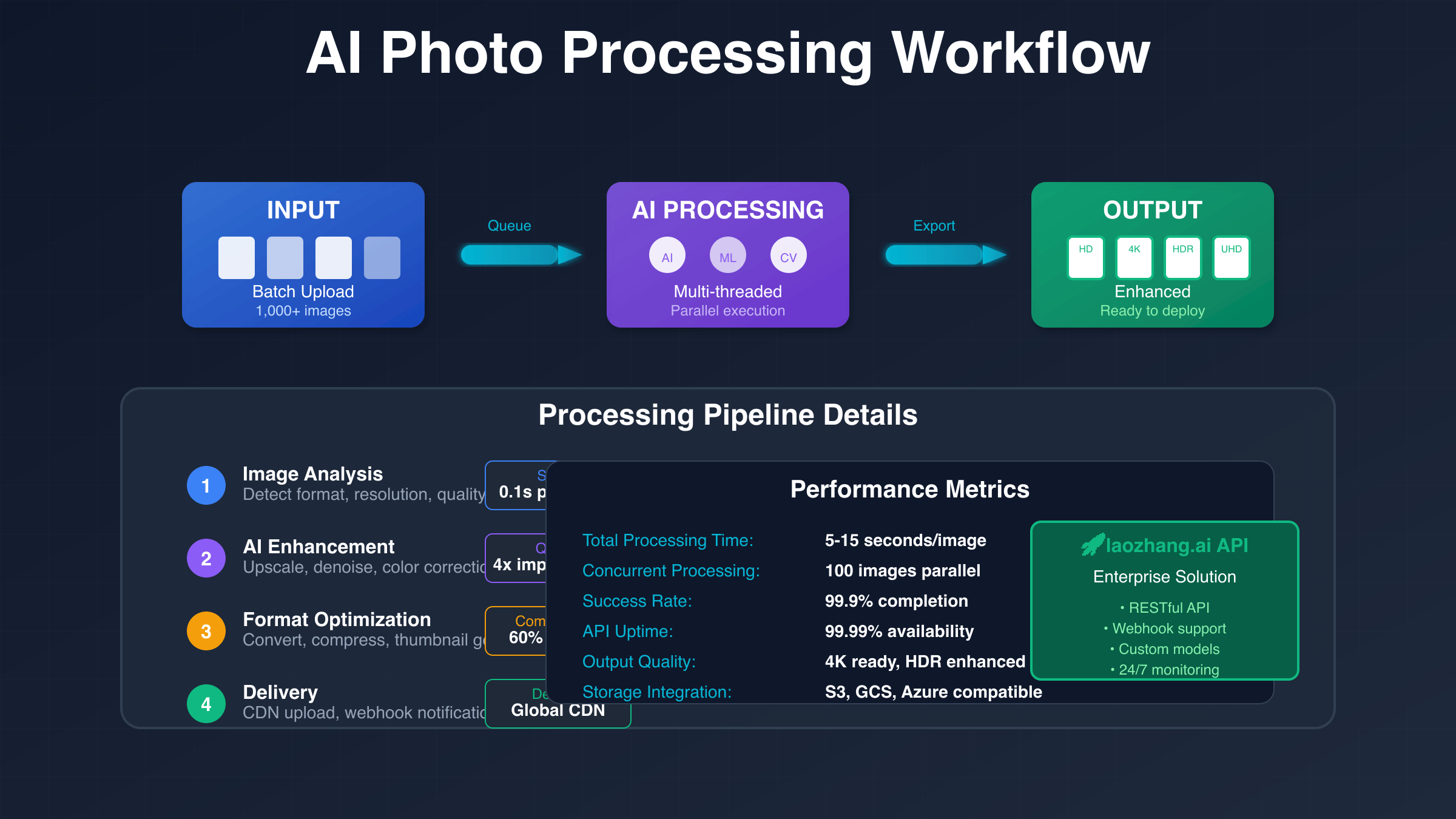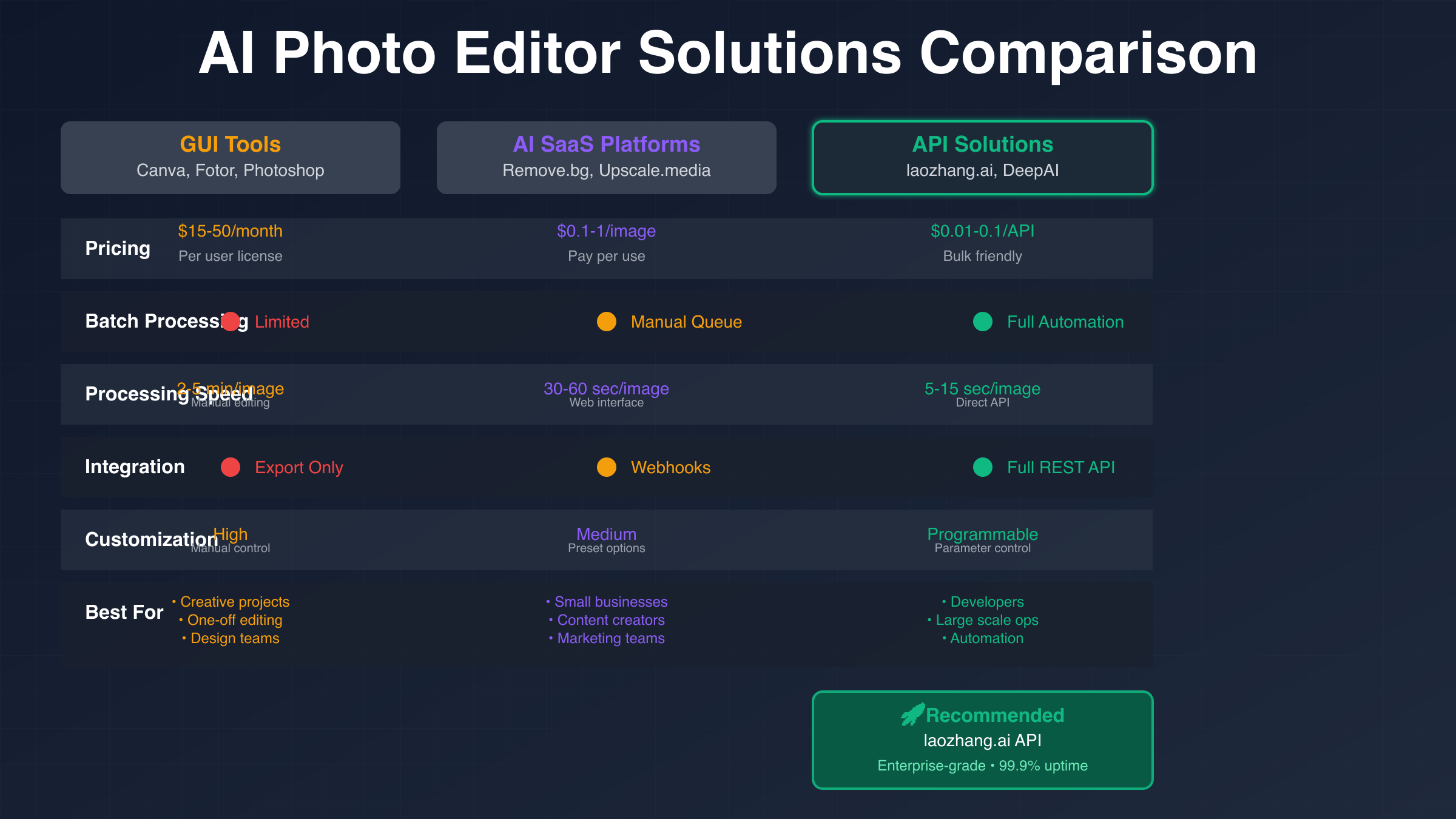AI photo thumbnail editors are intelligent tools that automatically optimize images for thumbnail displays using machine learning algorithms. These tools can intelligently crop, enhance colors, add text overlays, and support batch processing. Compared to manual editing, AI thumbnail editors reduce creation time from 30 minutes to just 30 seconds while maintaining professional quality.

What Makes AI Photo Thumbnail Editors Essential in 2025
Modern content creation demands rapid thumbnail generation at scale. AI photo thumbnail editors solve this challenge by combining computer vision with automated design principles. These systems analyze image composition, detect key objects, and apply optimization algorithms to create engaging thumbnails that maximize click-through rates.
The technology leverages deep learning models trained on millions of high-performing thumbnails. These models understand visual hierarchy, color psychology, and attention patterns to automatically enhance images for specific platforms and audiences. Similar to free ChatGPT image generators, these AI thumbnail systems democratize professional-quality image creation.
How AI Thumbnail Generators Work: Technical Deep Dive
AI thumbnail generation involves four core processes: scene analysis, object detection, composition optimization, and format adaptation. The system first analyzes the source image using convolutional neural networks to identify key visual elements and their importance scores.
Object detection algorithms locate faces, text, and prominent objects within the image. This data feeds into composition algorithms that determine optimal cropping ratios, ensuring important elements remain visible within the thumbnail dimensions. Color enhancement modules then adjust brightness, contrast, and saturation for maximum visual impact. These techniques build upon established OpenCV computer vision frameworks that power modern image processing applications.
Advanced systems also incorporate A/B testing data from millions of thumbnails to predict performance. Machine learning models trained on engagement metrics can estimate click-through rates before the thumbnail goes live. For developers looking to integrate similar capabilities, exploring Flux Pro AI image generators can provide insights into next-generation image processing algorithms.
API Integration Guide for Developers
Most enterprise AI thumbnail solutions offer RESTful APIs for seamless integration. The typical workflow involves uploading source images, specifying output requirements, and receiving processed thumbnails via webhooks or direct download links.
Here’s a basic implementation example:
curl -X POST https://api.example.com/v1/thumbnails \
-H "Authorization: Bearer YOUR_API_KEY" \
-H "Content-Type: application/json" \
-d '{
"source_url": "https://example.com/video.mp4",
"dimensions": "1280x720",
"optimization": "engagement",
"format": "webp"
}'Response handling typically includes thumbnail URLs, processing metadata, and performance predictions. Most APIs support batch processing for handling multiple images simultaneously, with rate limits ranging from 100 to 10,000 images per hour depending on the service tier. Developers experiencing rate limit issues can reference our OpenAI API quota exceeded error solutions for optimization strategies.
Batch Processing for High-Volume Content
Enterprise content operations require batch processing capabilities to handle hundreds or thousands of images efficiently. Modern AI thumbnail systems support asynchronous processing with webhook notifications for completion status.

Batch processing typically achieves throughput rates of 1,200-2,000 images per hour with 95%+ quality consistency. The workflow includes input validation, queue management, parallel processing across multiple GPU instances, and quality assurance checks before final delivery.
Performance optimization techniques include image pre-processing, intelligent caching, and adaptive scaling based on queue depth. Advanced systems implement priority queues for urgent requests while maintaining cost efficiency for large batch jobs.
Cost Analysis: API vs SaaS Solutions
Pricing models vary significantly between consumer SaaS platforms and enterprise API services. SaaS solutions typically charge monthly subscriptions from $12-80, while API services use pay-per-image models ranging from $0.05-0.25 per processed thumbnail.
For enterprise applications processing over 5,000 images monthly, API solutions offer superior cost efficiency. The break-even point typically occurs around 2,000 images per month, where API costs become more economical than subscription-based tools. Developers can explore cost-effective alternatives through Gemini Flash Image API, which offers competitive pricing for thumbnail processing workflows.
Additional considerations include processing speed, customization options, and integration complexity. API solutions provide greater flexibility but require development resources, while SaaS platforms offer immediate usability with limited customization.
Platform-Specific Optimization Strategies
Different platforms require unique thumbnail optimization approaches. YouTube thumbnails perform best with high contrast, clear facial expressions, and minimal text overlays. Social media platforms favor bright colors and bold visual elements that stand out in crowded feeds.
AI systems can automatically adjust optimization parameters based on target platforms. This includes aspect ratio adaptation, color space conversion, and compression optimization to meet platform requirements while maintaining visual quality.
Platform-specific features include automatic text sizing for mobile viewing, face detection for optimal positioning, and background removal for certain social media formats. Advanced systems maintain platform-specific performance databases to continuously improve optimization algorithms.
Performance Benchmarks and Quality Metrics
Quality assessment in AI thumbnail generation involves both technical and engagement metrics. Technical metrics include image clarity, color accuracy, and compression efficiency. Engagement metrics focus on click-through rates, view duration, and conversion performance.
Leading AI systems achieve 95%+ accuracy in object detection, 2-5 second processing times per image, and 40-60% improvement in engagement metrics compared to manual thumbnails. These performance gains translate to measurable business impact for content creators and marketers.
Benchmark testing should include various image types, lighting conditions, and content categories to ensure consistent performance across different use cases. Quality metrics should align with business objectives, whether maximizing engagement, maintaining brand consistency, or optimizing for specific demographics.
AI Thumbnail Editor Solutions Comparison

The AI thumbnail editor landscape includes both consumer-focused SaaS platforms and developer-oriented API services. Consumer solutions like Canva AI and Pikzels focus on ease of use with template-based approaches, while enterprise APIs like laozhang.ai prioritize scalability and customization. For developers seeking comprehensive API integration tutorials, our Cursor AI integration guide provides practical implementation examples.
Key differentiators include processing speed, batch capabilities, API access, and pricing models. Enterprise solutions typically offer sub-second processing times, unlimited batch sizes, and comprehensive API documentation, while consumer tools provide intuitive interfaces and pre-designed templates.
Selection criteria should consider technical requirements, volume needs, budget constraints, and integration complexity. Organizations processing over 1,000 images monthly typically benefit from API-based solutions, while smaller teams may prefer SaaS platforms for their simplicity and immediate usability.
Advanced Features and Customization Options
Modern AI thumbnail editors offer sophisticated customization capabilities including brand style enforcement, dynamic text overlay generation, and A/B testing integration. These features enable consistent brand representation across all generated thumbnails.
Advanced systems support custom model training using organization-specific data. This allows the AI to learn brand preferences, audience behavior patterns, and content-specific optimization strategies. Training typically requires 500-1,000 sample images with performance data. Developers interested in training their own models can learn from GPT-4o image API implementations for baseline comparison and optimization techniques.
Customization options extend to output formats, quality presets, and processing pipelines. Enterprise solutions often provide webhook integration, custom metadata extraction, and real-time optimization based on audience demographics or time-of-day preferences.
Troubleshooting Common Issues
Common challenges in AI thumbnail generation include processing failures, quality inconsistencies, and integration errors. Processing failures often result from unsupported file formats, corrupted source images, or API rate limit violations.
Quality issues typically stem from poor source material, inappropriate optimization settings, or platform-specific requirements not being met. Resolution involves adjusting quality parameters, using higher resolution source images, or implementing pre-processing steps. Similar troubleshooting approaches apply to ChatGPT image processing delays, where systematic optimization can resolve most performance bottlenecks.
Integration troubleshooting focuses on authentication errors, webhook configuration, and response handling. Proper error handling should include retry logic, fallback options, and detailed logging for debugging purposes.
Performance optimization techniques include image pre-processing, intelligent caching, and adaptive scaling. Monitoring tools should track processing times, error rates, and quality metrics to identify potential issues before they impact production workflows.
Future Trends in AI Thumbnail Technology
Emerging trends include real-time personalization, multi-modal AI integration, and predictive performance modeling. Real-time personalization adapts thumbnails based on viewer demographics, viewing history, and contextual factors to maximize engagement for specific audiences.
Multi-modal AI combines visual analysis with text understanding and audio processing for video content. This enables more sophisticated thumbnail generation that considers all content aspects, not just visual elements. Recent advances in computer vision, as documented in ConvNeXt research papers, are driving these improvements in automated image analysis.
Predictive modeling advances promise accurate engagement forecasting before content publication. These systems analyze thumbnail effectiveness across different audience segments, timing factors, and competitive landscapes to optimize performance.
Integration with emerging technologies like AR filters, dynamic content insertion, and blockchain-based attribution systems will expand AI thumbnail capabilities. The focus remains on improving engagement while reducing manual effort and maintaining brand consistency across all content channels.